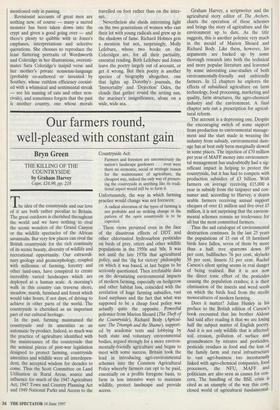Our farmers round, well-pleased with constant gain
Bryn Green
THE KILLING OF THE COUNTRYSIDE by Graham Harvey Cape, £16.99, pp. 218 The idea of the countryside and our love of it are both rather peculiar to Britain. The great outdoors is cherished throughout the world and we have nothing to rival the scenic wonders of the Grand Canyon or the wildlife spectacles of the African savannahs. But very few places can rival the British countryside for the rich continuity of its scenic beauty, diversity of wildlife and recreational opportunity. Our extraordi- nary geology and geomorphology, coupled with millennia of farming, forestry and other land-uses, have conspired to create incredibly varied landscapes which are deployed at a human scale. A morning's walk in this country can traverse shore, meadow, marsh, farmland and forest which would take hours, if not days, of driving to achieve in other parts of the world. The countryside is cherished as an important part of our cultural heritage.
In the past, farming maintained the countryside and its amenities as an automatic by-product. Indeed, so much was the practice of agriculture identified with the maintenance of the countryside that the seminal pieces of post-war legislation designed to protect farming, countryside amenities and wildlife were all interdepen- dent, the accepted wisdom for decades to come. Thus the Scott Committee on Land Utilisation in Rural Areas, source and influence for much of the 1947 Agriculture Act, 1947 Town and Country Planning Act and 1949 National Parks and Access to the Countryside Act:
Farmers and foresters are unconsciously the nation's landscape gardeners . . . even were there no economic, social or strategic reason for the maintenance of agriculture, the cheapest way, indeed the only way of preserv- ing the countryside in anything like its tradi- tional aspect would still be to farm it.
Unfortunately, the way in which farming practice would change was not foreseen:
A radical alteration of the types of farming is not probable and no striking change in the pattern of the open countryside is to be expected.
These views persisted even in the face of the disastrous effects of DDT and other chlorinated hydrocarbon pesticides on birds of prey, otters and other wildlife populations in the 1950s and '60s. It was not until the late 1970s that agricultural policy, and the 'dig for victory' philosophy on which it was based, at last began to be seriously questioned. Then irrefutable data on the devastating environmental impacts of modern farming, especially on hedgerow and other habitat loss, coincided with the revelation of huge farming subsidies, vast food surpluses and the fact that what was supposed to be a cheap food policy was actually quite the opposite. Powerful polemics from Marion Shoard (The Theft of the Countryside), Richard Body (Agricul- ture: The Triumph and the Shame), support- ed by academic texts and lobbying by both state and voluntary environmental bodies, argued strongly for a more environ- mentally-friendly agriculture and began to meet with some success. Britain took the lead in introducing agri-environmental schemes into the Common Agricultural Policy whereby farmers can opt to be paid, essentially on a profits foregone basis, to farm in less intensive ways to maintain wildlife, protect landscape and provide access. Graham Harvey, a scriptwriter and the agricultural story editor of The Archers, charts the operation of these schemes and brings the story of agriculture and the environment up to date. As the title suggests, this is another polemic very much in the mould of Marion Shoard and Richard Body. Like them, however, his arguments are backed up by some thorough research into both the technical and more popular literature and leavened by some interesting case-studies of both environmentally-friendly and unfriendly farmers. In 12 chapters he explores the effects of subsidised agriculture on farm technology, food processing, marketing and quality, farm structures, the agro-chemical industry and the environment. A final chapter sets out a prescription for agricul- tural reform.
The account is a depressing one. Despite the encouraging switch of some support from production to environmental manage- ment and the start made in weaning the industry from subsidy, environmental dam- age has at best only been marginally slowed in some places. The injection of £70 million per year of MAFF money into environmen- tal management has undoubtedly had a sig- nificant impact in helping to protect the countryside, but it has had to compete with production subsidies of £3 billion. With farmers on average receiving £15,000 a year in subsidy from the taxpayer and con- sumer and, according to Harvey, a dozen arable farmers receiving annual support cheques of over £1 million and five over £5 million, it is not surprising that the environ- mental schemes remain an irrelevance for all but the most committed farmers.
Thus the sad catalogue of environmental destruction continues. In the last 25 years the populations of 15 out of 18 farmland birds have fallen, seven of them by more than a half: tree sparrows down 89 per cent, bullfinches 76 per cent, skylarks 58 per cent, linnets 52 per cent. Rachel Carson's silent spring seems in real danger of being realised. But it is not now the direct toxic effect of the pesticides causing the population crashes; it is their elimination of the insects and weed seeds on which the birds feed from the sterile monocultures of modern farming.
Does it matter? Julian Huxley in his preface to the British edition of Carson's book recounted that his brother Aldous had said after reading it that we are losing half the subject matter of English poetry. And it is not only wildlife that is affected: soil erosion, pollution of surface and groundwaters by nitrates and pesticides, pesticide residues in food and the loss of the family farm and rural infrastructure to vast agri-business too incestuously linked with agro-chemical companies, food processors, the NFU, MAFF and politicians are also seen as causes for con- cern. The handling of the BSE crisis is cited as an example of the way this cosy, closed world of agricultural fundamental- ism operates.
Harvey ultimately attributes all these ills to subsidies and his prescription to right them is to remove the support from the industry. This has happened in New Zealand where exposure of farmers to world prices has not resulted in predicted rural collapse, but reduced land prices inflated by subsidies, made the entry of young newcomers to farming thereby easier, diversified cropping patterns, low- ered sheep numbers, diversified wildlife, encouraged forestry on marginal erodible farmland and reduced the price of food.
Whether the result would be the same in Europe is open to debate. Much will depend on world prices. Buoyed by recent high prices resulting from poor harvests and increasing demand from Pacific Rim countries adopting more western diets, the agricultural industry finds itself in curious alliance with the more radical environmen- tal organisations. Both are predicting world food shortages as a result of population growth, climate change and desertification and arguing for the foot hard down on the accelerator of production.
Some authoritative academic studies suggest, however, that there is potentially huge over-production capacity in Western European agriculture and that, if, or when, Eastern European farming gets itself organised, this will be vastly increased. That there should be such an enormous divergence of views on the security of world food supplies, which is arguably the most important issue facing mankind, is typical of the uncertainties in farming, still the most risky and unpredictable of businesses. This has always been the fundamental case for some baseline support of the industry and many would argue always should be.
Harvey perhaps tends to be over- optimistic in assessing the extent to which eliminating subsidies would set us back on a path to smaller, more environmentally- friendly organic farmers. And he perhaps underestimates the extent to which modern technological agriculture has become more environmentally friendly and might become even more so if only best practice were to become general practice. He certainly underestimates how tied we are to the CAP. Whilst member countries such as Denmark and the Netherlands are more progressive on environmental issues than Britain, others, particularly France and southern European states, are much less so. All other EU countries have smaller farms, thus many more farmers and even more powerful agricultural fundamentalist lobbies than ours pushing for gung-ho sub- sidised production. Whilst some continuing CAP reform is inevitable, the forces con- straining it are very powerful. By and large, however, Graham Harvey has provided a forceful, informed and authoritative account of the state of farming and the countryside which could not be more time- ly with a new government in office.











































































 Previous page
Previous page